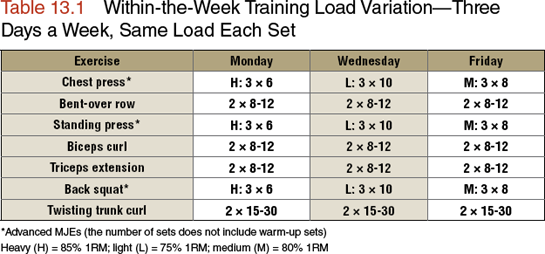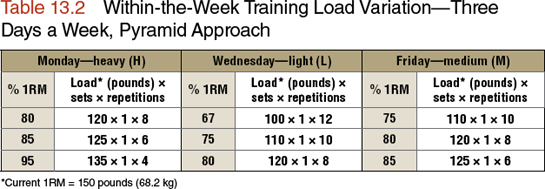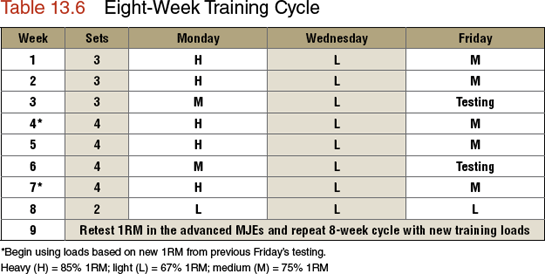
This step builds on the discussion in step 12 of applying program design principles associated with exercise selection, arrangement, loads, repetitions, sets, rest periods, and training frequency by describing how these program design elements can be manipulated to maximize training outcomes.
If you perform the same number of sets and repetitions on the same days each week and with the same loads week after week, a plateau in strength will occur, and you will not meet your goals for training. The program design variables need to be systematically varied in order to promote continued improvements and avoid overtraining.
Although performing greater numbers of repetitions and sets and lifting heavier loads is necessary in order for improvement to continue, performing too many repetitions and sets with aggressive loads and without adequate rest periods can result in injury, extended muscle soreness, and aggravated joint problems. The goal, therefore, is to design programs that vary the overall intensity of training and provide the needed overload and rest to produce maximum improvements without injury.
Training variation involves efficiently manipulating the variables of
training frequency,
exercise selection,
exercise arrangement,
number of repetitions per set,
number of sets, and
length of the rest periods.
Programs that are designed to vary the intensity of training give special attention to the loads assigned or calculated for the large muscle multi-joint exercises (MJEs) discussed in step 12. Further, you may recall that a certain advanced group of MJEs— those that train the chest, shoulders, and legs as well as the total-body—qualify for the 1RM method of determining training loads because they train the largest muscle groups, which are better able to withstand the rigors of weight training than smaller muscle groups. Those MJEs were also identified as being appropriate for the heavier loads used in pyramid training as part of a muscular strength program. Be aware that the MJEs mentioned in the discussions and examples of this step refer to that advanced group of MJEs, not all MJEs (and definitely not the SJEs).
Some of the common strategies used to vary the intensity of workouts are to
lift heavy, light, and medium loads on different days of the week;
increase loads from week to week; or
change loads in a cyclical or repeated manner every two to four weeks.
These strategies can be applied to MJEs and programs designed to increase muscular strength and hypertrophy because they typically involve performing three or more sets of the MJEs. (The loads used for SJEs should continue to allow 8 to 12 repetitions and follow the two-for-two rule to gradually increase the loads.) Although the discussion here focuses on the loads assigned for the various programs, you should realize that the number of repetitions and sets can also be manipulated to vary training intensities.
There are three primary methods of designing a program that includes changes in the loads lifted during one training week. Again, remember that any numerical or relative loading guidelines refer to changes made to MJEs only.
Table 13.1 shows you an example of a three-days-a-week workout program in which heavy (H), light (L), and medium (M) loads are varied within the week. The loads used in a particular day’s workout do not change (thus the “same load in each set” name). The table uses abbreviations: 3 × 6 means 3 sets of 6 repetitions and 2 × 8-12 indicates that you should perform 2 sets of 8 to 12 repetitions. If you completed 3 sets of 8 to 10 repetitions with 120 pounds (54.5 kg), you would write it like this: 120 × 3 × 8-10.
Notice that in table 13.1 only the MJEs are associated with the letters H, L, or M designating the use of heavy (85 percent of 1RM for 6 repetitions), light (75 percent of 1RM for 10 repetitions), and medium (80 percent of 1RM for 8 repetitions) loads, respectively. The SJEs use loads that permit 8 to 12 repetitions. Even though you may be able to, do not perform more than 10 repetitions on your light day or more than 8 repetitions on your medium day. Notice that Monday (in table 13.1’s example), the most intense training day, is followed by the least intense training day, which is then followed by a medium-intensity day so that your body has a chance to recover. This pattern repeats itself in all the training-program examples provided in this step.

In step 12 you learned about the use of the pyramid approach in which progressive load increases occur from one set to another until all sets for a specific exercise are completed. In table 13.2 you will recognize these progressive increases, but you should note that the loads used vary from 80 to 95 percent of 1RM on Monday (H), from 67 to 80 percent on Wednesday (L), and from 75 to 85 percent on Friday (M). The example uses a 1RM of 150 pounds (68.2 kg) and the loads are rounded down to the nearest 5-pound (2.3 kg) increment.

Tables 13.3 and 13.4 show how a four-days-a-week (split) program can be organized to vary heavy and light loads within the week. Table 13.3 shows the assignment of loads on Monday and Thursday for the chest, shoulders, and triceps. Table 13.4 shows load assignments on Tuesday and Friday for the legs, back, and biceps. Again, it is important not to perform more than 12 repetitions on your light day even if you are able to.
Table 13.3 Monday-Thursday Split Program—Chest, Shoulders, and Triceps
| Exercise | Monday | Thursday |
| Bench press* | H: 4 × 6 | L: 3 × 12 |
| Dumbbell chest fly | 4 × 8-12 | 3 × 8-12 |
| Shoulder press* | H: 4 × 6 | L: 3 × 12 |
| Triceps pushdown | 4 × 8-12 | 3 × 8-12 |
| Extended abdominal crunch | 2 × 15-30 | 2 × 15-30 |
* Advanced MJEs (the number of sets does not include warm-up sets)
Heavy (H) = 85% 1RM; light (L) = 67% 1RM
Table 13.4 Tuesday-Friday Split Program—Legs, Back, and Biceps
| Exercise | Tuesday | Friday |
| Back squat* | H: 4 × 6 | L: 3 × 12 |
| Knee curl | 4 × 8-12 | 3 × 8-12 |
| Standing heel raise | 4 × 8-12 | 3 × 8-12 |
| Lat pulldown | 4 × 8-12 | 3 × 8-12 |
| Seated row | 4 × 8-12 | 3 × 8-12 |
| Low-pulley biceps curl | 4 × 8-12 | 3 × 8-12 |
* Advanced MJE (the number of sets does not include warm-up sets)
Heavy (H) = 85% 1RM; light (L) = 67% 1RM
Table 13.5 shows two ways to increase loads on a weekly basis. Option A involves simply scheduling a small percent increase each week. Option B also shows a small percentage of increase (Monday) each week, followed by the use of light and medium loads on Wednesday and Friday, respectively. Remember that the percentages shown apply only to MJEs.
The strategies previously explained in this step describe how to vary the intensity of your weight training program. If, however, you were to continue following one of those programs for an extended period of time, you would most likely experience a plateau or an overtraining injury. Remember the earlier emphasis on the need for proper rest? Programs that continue to increase loads, repetitions, or sets without scheduling rest time will not produce optimal gains. To counteract that risk, you should follow the concept of periodization, which refers to the purposeful scheduling or cycling of high-intensity training periods and low-intensity training periods.
A typical periodization strategy divides a program into time periods. The largest division is a macrocycle, which usually lasts an entire training year but may range from one month to four years (for Olympic athletes, for example). Within the macrocycle are two or more mesocycles that last several weeks to several months. Each mesocycle is divided into two or more microcycles, each of which is usually one week long. These cycles are incorporated into two general types of periodization models, linear and undulating. In the linear model, the intensity (load) is consistently increased over time while the volume (sets and repetitions) is reduced. The non-linear or undulating model is characterized by the intensity and volume being from varied day to day and from workout to workout.
The training program described in table 13.6 represents an eight-week cycle (for advanced MJEs only) that includes load variations within the week (undulating) and load increases after every three weeks (linear) until the eighth week.
Follow the guidelines for loading and sets for each heavy, light, and medium training day. On Friday of the third and sixth weeks, complete the following procedures as an abbreviated way to determine a new 1RM to use when calculating the new training loads:
1. Warm up as usual, then use Friday’s loads in sets 1 and 2 (and 3 for week 6), but perform only 5 and 3 repetitions (6, 4, and 2 repetitions for week 6), respectively.
2. If you are using the pyramid method, perform as many repetitions as possible with the heaviest load used thus far in this cycle (specific to the exercise being tested). If you are using the same load in each set, increase the load lifted in the last set by 10 pounds (4.5 kg) and perform as many repetitions as possible.
3. Predict the 1RM using the procedures you learned in step 12 (see page 160). A shortcut method for identifying training loads is described in the next section.
In the fourth and seventh weeks, the loads lifted are based on new calculations using the newly tested 1RMs that were determined during the Friday workout of the third and sixth weeks. Notice that the eighth week involves lighter loads and fewer sets (resulting in less intensive workouts), providing an opportunity for the body to recover as well as to increase strength levels in succeeding weeks. The number of sets may also be increased after each three-week period. A four-days-a-week program could be cycled in a similar way.

Instead of multiplying the 1RM by the desired training percentage to determine training loads as you did in step 12, refer to table 13.7 and follow these steps:
1. Locate and circle your 1RM value in the “1RM” column.
2. Identify the desired training percentage (65 to 95 percent).
3. Follow the percentage column down until it meets the row for your 1RM and circle that number—this is your training load.
Figure 13.1 shows an example of this shortcut. In the example, the lifter completed seven repetitions with 90 pounds (40.9 kg) and wants a training load that represents 80 percent of 1RM. Completing seven repetitions with 90 pounds (40.9 kg) equals a 1RM of 110 pounds (50 kg) using the procedures to predict the 1RM explained in step 12 (see page 160). In table 13.7, under the column heading “1RM,” 110 pounds (50 kg) is found on line 19. The number at the intersection of line 19 and the 80 percent column is the calculated training load (88), which is rounded down to the nearest 5 pounds (2.3 kg) or weight-stack plate (85 pounds [38.6 kg]).
Regardless of the method you use to create variations in intensity, you should perform as many repetitions of the MJEs as possible on the heavy days of your workout schedule, but keep them within the designated ranges during the Wednesday (light) and Friday (medium) workouts. This means that even though you may be capable of performing more repetitions with the lighter Wednesday and Friday loads, don’t do it! In the SJEs, use the two-for-two rule for increasing loads.
Program Variation Self-Assessment Quiz
Mark the correct choice in each of the following statements. Answers are on page 205.
1. The repetitions performed on light and medium training days allow you to [___ apply the overload principle ___ recover from the overloading].
2. You should perform [___ the designated number of repetitions ___ as many repetitions as possible] on heavy training days.
3. The two variables that have been manipulated in the eight-week training cycle in table 13.6 are [___ repetitions and sets ___ loads and sets].
Maximizing Training Drill 1. Shortcut Method
This drill is designed to give you experience in the shortcut method of determining training loads using table 13.7. Assume that you performed the “as many repetitions as possible test” with 150 pounds (68.2 kg) and were able to complete 8 repetitions. If you want to use 75 percent of 1RM, what is the correct training load? Remember to use the procedures for predicting the 1RM from step 12 first (refer to the example in figure 12.4, page 163), and then use this 1RM value and the 75 percent 1RM column of table 13.7 to locate the correct training load. Round this value down to the nearest 5-pound (2.3 kg) increment or weight-stack plate. The answer is on page 205.
Success Check
Associate the number of repetitions completed with the repetition factor (see table 12.4).
Multiply the repetition factor by the load lifted to determine the 1RM.
Locate and circle where your 1RM value is located in the “1RM” column (see table 13.7).
Identify the desired training percentage column.
Identify the intersecting point.
Round this value down to determine the training load.
Maximizing Training Drill 2.
Determining Training Loads in a Program
To give you another opportunity to determine training loads, fill in training loads for the program shown in figure 13.2. In this drill, assume that five repetitions were performed with 105 pounds (47.7 kg). Answers are on page 205.
Success Check
Associate the number of repetitions completed with the repetition factor (see table 12.4, page 163).
Multiply the repetition factor by the load lifted to determine the 1RM.
Locate and circle the 1RM value on table 13.7.
Multiply the desired training percentage by the 1RM.
Round this value down to determine the training load.

Training intensity can be varied in many ways, but the most common methods involve manipulating the amount of the load, the number of sets and repetitions, and the number of training days. The use of periodization programs that include aggressive training weeks followed by a week (or weeks) of less aggressive training provide an appropriate overload and an opportunity for the body to recover and make significant gains.
As you become more experienced, you may want to learn more about periodization. Detailed discussions can be found in the texts by Baechle and Earle (2008) and Earle and Baechle (2004).
Step 14, the last step, allows you to apply everything you have learned about developing your own weight training program. You will be prompted to use your knowledge about the program design variables described in the last two steps and apply the overload and specificity concepts to design a program that meets your needs. Enjoy the challenge!
Before Taking the Next Step
Honestly answer each of the following questions. If you answer yes to all of the questions, you are ready to move on to step 14.
1. Have you completed the self-assessment quiz and the drills and checked your answers?
2. Do you understand how to manipulate training variables to maximize training?
3. Can you calculate new training loads using table 12.4 and table 13.7?